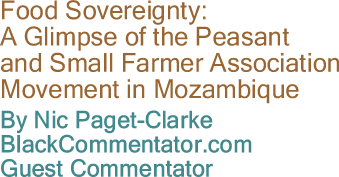
|
|||||||||||||||||||||||

|
||||||||

Custom Search
|
||||||||
 |
||||||||
Mr. Paget-Clarke recently returned from Niassa and Maputo Provinces in Mozambique. Being in a field in southern Niassa province, in Mozambique, listening to a group of women and men members of a peasant and small farmers’ association sing a cappella while they wield their hoes is both thrilling and supremely humbling. Particularly when you realize that the song is being improvised and that they are singing about their association movement and thanking you for dropping by.
I was in Mozambique because I was fortunate enough to be invited to attend the Fifth International Conference of La Via Campesina in Matola, a suburb of the capital city Maputo. La Via Campesina is an organization of organizations, a powerful aspect of the growing movement of peasants, family farmers, indigenous and landless people of the world. My goals were to help record the conference by interviewing some of the delegates and to learn more about the campesin@ way of life and how that way is crystallized in a call for and a practice of food sovereignty. In particular, I wanted to learn what that means to the peasants and small farmers of Mozambique. Diamantino Nhampossa is the executive director of UNAC (União Nacional de Camponeses / National Peasants' Union) and also a member for Africa on La Via Campesina’s international organizing committee. When he spoke to me, he told me, “ (t)he Via Campesina model for development, which is food sovereignty, is a model which can be accessible to the rural poor in this country. ... what we do as an organization is make sure that the local organizations, associations, grassroots organizations have power to look for solutions to their own problems. We do that promoting a lot of meetings, organizing a lot of training, a lot of exchanges to strengthen the farmers to be able to look for solutions for their own problems.”
To help me understand what that means “in our reality”, as one association member described it, he set me up with UNAC Niassa advocate director Julio dos Santos Pessego. Niassa province is in northwest Mozambique and three hours by jet from Maputo. With Pessego (as everyone calls him -- Pessego means peach) I visited four Niassa associations. With us were Portuguese/English interpeter Edgar Basilio Ussene, UCA (Union of Associations and Cooperatives of Lichinga) leaders Alifa Aide and Xavier Jaime who also translated from Yao to Portuguese, and UCA president Carlos Afana). After Niassa, I visited association members in Marracuene in southern Mozambique. What follows is what they told me. Issues of food In the field I mentioned above, Francisco Quenesse explained why members of his Lichego community, in the Sanga district adjacent to Lichinga, Niassa’s capital, formed their First of December Association. “We have come together to constitute an association to resolve issues of food.” Sitting in the courtyard behind a home in the village of Meponda, a community on the shores of Lake Niassa, president of the community Julieta Musse told us, “We constituted the organization because we believe that joint efforts are better than working alone. We also believe that when you are in an association you can have a different experience. Jointly you can advance and improve production.” The goal of increasing the production of food was central to the formation of all the associations I talked with. What I discovered was that the process of the association led to this and very much more. When more than one family works together, they told me in the Lusanyando community outside of Lichinga, they increase the area of cultivation and also the yield. This greater yield allows for greater diversity of crops. This greater diversity, they said, allows other crops to compensate if one crop fails. The diversity of crops, of foods, improves the diet and people’s health. And, yes, the diversity of crops, the diversity of diet, is traditional agriculture in their area.
And what else does this increased production allow for? First of all, it allows the members to feed their families. In Meponda, Omar Bonomar put it this way, “Why we realized we wanted to join is before my wife was a member of the association we had problems buying small things like salt, fish, oil, a lot of things. But when my wife joined the association these problems were overcome -- we were able to buy salt, oil, fish, different products to prepare meals. ... we were suffering and now we are not. The association is making money. We decided to join the association.”
Beyond this, in every community I visited, the surplus food was either sold in the community, sold to market traders, or taken directly to a local market. Usually, the extra harvest was sold by the association as a group. Depending on the size of the association and the day at the market, the money from the sale was distributed to individual families and also used to collectively invest in the association and the community as a whole in a variety of ways. These ways included buying new seeds, buying new tools, renting a tractor, hiring technicians, accessing healthcare, helping to build mosques, and developing sanitation. In the individual families, I was told several times, funds were used to purchase exercise books, pencils, and clothes to assist their children at school. They are also used to build new brick houses. For example, when we visited the Ncachelenga Women’s Association in Namacula, near Lichinga, I learned that their 13-member association had been able to build three brick houses, and a new chicken house, to replace traditional cane houses. More on collective marketing was explained to me in Marracuene by Arnoldo Uache, the UNAC secretary of rural development for Marracuene. He spoke as we walked from field to field (with interpreter Justino Baloi) talking to different association members. In Marracuene, there are 23 registered associations, though there are more like 40 associations if you include the not-yet registered ones, with about 4,500 to 6,000 peasants and farmers involved. The associations are clustered into four nuclei of associations which together form UCAM, the Union of Agricultural Cooperatives of Marracuene. The nuclei represent the communities of Marracuene, Moamba, Boane, and Manhica communities. Marracuene is in the valley of the Nkomati River. Anyway, when, for example, an association’s bananas are ripe, the members get together to discuss what to do with them. First, they ask if anyone needs to buy any. Those are sold to the members at a very low price. Then, the others are sold to market traders (by the association) and that money goes to the association for distribution, as described before. A similar special arrangement for members takes place at the headquarters of UCAM where sapling fruit trees are planted and nurtured. Members pay a token price for new plants.
It is in this context of self-reliance and a supportive economy that some associations receive donations, such as water pumps from an organization in Spain to UCAM in Marracuene, or a small milling machine to the Casa Agraria Association in Meponda. They assist but do not, as Diamantino Nhampossa said, “alter the direction and sovereignty of the peasants.” Horizontal networks And the flow of that direction is quite diverse -- within the associations, within the communities, between associations and communities. In Lusanyando, I learned that in 1992 their association began with two members, now there are 13 associations each with fifteen to 25 members. In Namacula, there are 62 associations, each with 13 to 20 members. In Marraucene with its 40 cooperatives, Tomas Honwana of UCAM said, “ ... at the association level, each day we have someone joining the association.”
Along with all this growth of associations within the communities, the associations also network. The network which unites to form the Marracuene union of associations UCAM is one example. Within Niassa two examples are UCA (Union of Associations and Cooperatives of Lichinga) and UCASNE (Union of Cooperatives and Associations of Southern Niassa). When I first arrived in Lichinga we went to meet some of the leaders of UCA in their office. The white board on the wall was a mass of interconnecting associations and groups of associations. Yet, as I went from association to association, each one was the center of their own activity, of who was responsible for what they were doing. It was very much a horizontal network.
Exchanging ideas In conversation with association members, it was repeatedly made clear that flowing through these network channels organized by UNAC, UCA, UCANSE, and UCAM, were ideas, training, and support. For example, the Ncachelenga Women’s Association described how after their association grew from two women to a group and they saw how things were improving, they decided they wanted to go further. “We needed to identify who could help us, and we identified UCA. We drew up a list of our members and went to UCA and said, ‘This is our group. What we are doing is we have a field and we are cultivating it. We are a group a women and we would like to have the support of UCA.’ UCA responded positively giving hoes and seeds. Also UCA gave to the group manure and other fertilizers. Then UCA thought that this would not be enough and they suggested to the group that we raise chickens and also use that manure in the field.”
On this point, specifically, Diamantino Nhampossa says that UNAC is developing more agroecology-based training. As an example of these methods already in use, several people described organic fertilizers. In Lichego, Francisco Quenesse described what they were doing when we visited. They were planting potatoes under furrows holding rotting vegetation timed to release nutrients as the potatoes grow to the surface. Lastly, within the communities themselves, the associations described their growing role. In Meponda, Filomena Aualo, president of the April 7 Women’s Association, spoke of receiving training on HIV issues and helping to spread within the community information combatting HIV. In Lusanyando, we were told, “... associations help the community to access water to drink. The association was the one who worked hard to have water here. ... the associations helped the community to solve land conflicts.”
Which brings me back to what Julieta Musse earlier told us, “... that when you are in an association you can have a different experience.” Similarly, in Marracuene, standing on deep riverbed-black soil, among fields of bright green vegetables, in particular cabbage which seemed to be bursting, I met Vasco Macuacua, president of the Bolazo B Association, who said, “ ... they tend to come because they have seen that there is a lot of improvement when they join the association. The people who belong to the association have changed their lives. ... as a group they exchange ideas, and those ideas they can expand to their communities.” And in those communities the diversity of ideas is not just seen in the crops, the foods, it is also in the diversity of the associations themselves. Some associations come together as small or large groups of families. Some people unite around the need to farm near a river, others to share access to a water channel. In some the land is divided up and worked by families, while other land is worked collectively. In one the collective land was used to learn about new methods of planting. Some have no collective land. One form of association that I learned of almost immediately was women’s associations. When I asked the women of the Ncachelenga Association, “Why?” they said that, basically, it was an affirmation of equality by organization. This way they could ensure that they received their equal share of the money made at the market from selling the harvest. In Meponda, Filomena Aualo said that sometimes men don’t see the advantage of working in an association, so the women form them themselves. But she said, graciously, “Sometimes, the women go there and work and when they get revenue they buy trousers for the husband who was forbidding his wife to go to work in the association.” In Meponda, there is even the occasional man who joins a women’s association. In Lusanyando, one man said, “A woman is also a human and they have a right to have their own group to do what they need. In this kind of association the women are the ones who decide what to produce and the women decide what to do with their revenues without the influence of men.” A creative response But all of this is not to say that there are no problems. In fact, it is because of problems, particularly of access to adequate food, that most of the associations form. And even with associations there are problems. I was told of having to work with poor soil, of soil ruined by earlier use of chemicals. I was told of not having enough resources to accomplish the projects they have in mind. Or of tools that are difficult to use. People have to ride 60 kilometers on dirt roads to get to a market in the back of a pickup truck really not designed for public transportation. There are problems of access to water, education, and healthcare. Diamantino Nhampossa explained that in 1987 International Monetary Fund loan conditions were imposed on Mozambique and since then industry has been privatized (mostly sold to Portuguese and multinational companies), ruining in particular agricultural processing industries such as cotton, textiles, and tea. Profits that are made, for example by Coca Cola and aluminum companies, leave the country. Dependence on outside countries has increased. The much-discussed massive introduction of industrial agriculture threatens to nullify the food security available as a result of the independence-era land reforms. The associations are a creative response to a difficult situation, and a creative response that relies on developing a supportive or solidarity economy rather than one which relies on exploiting other people. The Mozambique movement to create peasant and farmer associations is food sovereignty in action. I asked Pessego several questions about food sovereignty and associations. He said, “ The situation for peasants in Niassa is improving because it is not like before, years ago, because now the peasants understand the issues of associations. But, on the other hand, it is necessary to develop efforts to reach all communities. ... With self initiative, people come together and try to find training. To proceed they need self-analysis to understand the area where they are living, what are the main problems that they would like to overcome. ... Before, people didn’t understand this saying, food sovereignty. But now people are trying to do diversification of crops to respond to food sovereignty. ... They know how to manage and they know the objective of being a member of an association. They know the objective of an association.” BlackCommentator.com Guest Commentator Nic Paget-Clarke is Publisher and Co-editor of In Motion Magazine where this article originally appeared December 16, 2008. In Motion Magazine ® is a multicultural, online U.S. publication about democracy. Click here to contact Mr. Paget-Clarke. |
||||||||
Any BlackCommentator.com article may be re-printed so long as it is re-printed in its entirety and full credit given to the author and www.BlackCommentator.com. If the re-print is on the Internet we additionally request a link back to the original piece on our Website. Your comments are always welcome. eMail re-print notice
If you send us an eMail message we may publish all or part of it, unless you tell us it is not for publication. You may also request that we withhold your name. Thank you very much for your readership. |
||||||||
| |
||||||||










































